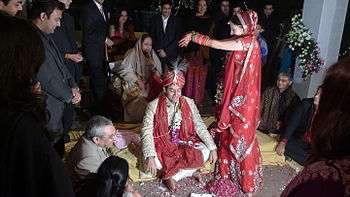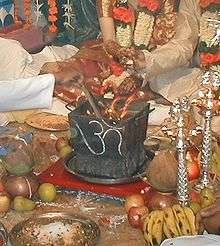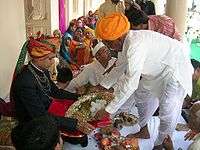Weddings in India


Weddings in India are filled with ritual and celebration that continue for several days. Usually around 100 to 10,000 people attend. Attendees are frequently not known directly by the bride and groom.
Though most Indian marriages are arranged,[1] some couples in urban areas consummate "love marriages", in which the partners decide to marry each other without family involvement or assistance. The traditional Indian wedding is about two families being brought together socially, with as much emphasis placed on the families coming closer as the married couple.
Many wedding customs are common among Hindus, Jains, Sikhs and Muslims. They combine local, religious and family traditions. The period of Hindu wedding ceremonies[2] dates from the application of tilak.
Weddings in India are a mainstay in the social calendar of the whole community. Many wedding traditions originated in India. Increasingly, Western features are incorporated, such as speeches, the first dance and the traditional wedding cake.
South Asian-style weddings are typically very lavish, typically at the behest of the bride.
Forms of marriage
The Hindu Vedic system recognizes the validity of several forms of marriage:
- Brahmana, in which the father of the bride sends an invitation to a properly qualified man and entrusts the girl to him; the purpose of the marriage is the joint performance of the traditional religious duties
- Daiva, in which the girl is married to a properly qualified brahmana who was invited to perform a sacred ritual; the purpose of the marriage is to perpetuate the good results of the sacrifice and to protect society in general
- Arsha (of the Rishis), in which the married couple offer a symbolic gift of a bull and a cow (sacred animals considered the father and mother of human society) to the girl’s parents; the purpose of the marriage is cooperation in the study and practice of spiritual life
- Prajapatya, in which the girl chooses a suitable husband directly or indirectly (for example in svayamvara tournaments); the purpose of the marriage is the birth of a qualified progeny that will continue the dynasty
- Gandharva, in which the girl and boy declare their love for each other (this is also the specific ritual for gays and lesbians, according to the 12th century commentator Jayamangala) and exchange vows and garlands; the purpose of the marriage is romantic desire and sensual pleasure – as exemplified in the story of Shakuntala and Dushyanta
- Rakshasa, in which the girl is abducted from her home against the will of her family; this type of marriage is also popular with Kshatriyas who want to overcome the blind opposition of the girl’s family to her wishes (as in the cases of Krishna’s wife Rukmini and sister Subhadra, who married Arjuna)
- Asura, in which a girl and her family receive gifts, boons or wealth from the prospective husband to convince them of his good intentions; the most famous example in puranic history is Shantanu, who married Satyavati by pledging exclusive succession rights to Satyavati’s sons
- Pisacha, in which a girl is seduced into a sexual relationship by flattery, emotional pressure, mental manipulation, intoxication (with wine etc.), or approached while she is sleeping and more vulnerable. The purpose of the pisacha marriage is mere satisfaction of sensual pleasure but still the women involved and the children conceived in such relationship are considered perfectly respectable by society.
Traditional marriages
Wedding traditions vary across religion, caste, ethnicity, language, region, etc. Traditional Indian weddings are generally structured into pre-wedding ceremonies, wedding day ceremonies (consisting of the Baraat, the Varmala and the Satphere), and the Vidaai. When the marriage has been agreed upon, the father of the bridegroom visits the father of the bride.
The day before the expected arrival of the wedding procession,[3] lavish preparations are done by the family to receive the groom (shaadi ki tayaari) in beautiful and decorated venues, typically farmhouses or hotel halls, where a sacrificial fireplace called marhwa is built. Brides decorate themselves with gold and diamond jewellery, apply mehndi to colour hands and feet, and undergo various bridal rituals, including wearing bridal lehenga or saree. Bridegrooms typically wear a [sherwani] dress or a designer suit. To complete the marriage, the bride and groom walk in a circle (phera) around the sacrificial fire.
Vidaai is when the bride is formally sent to the groom’s household. Many songs have immortalized this moment when the bride leaves her ‘babul ka ghar’ or father’s house.[4] According to Hindu religious texts, Brahma created man from the right shoulder and woman from his left shoulder. A woman is referred to as Vamangi or one who is on the left side.
Throughout the wedding ceremony the bride sits on the right side of the groom. That is the place for strangers and acquaintances. Only after the Saptpadi, when the bride and groom have exchanged marital vows, is the wife seated on the left side of the man. An example of the complexity of an Indian wedding can be seen from the various phases of a wedding in North India. The following events take place in a typical Eastern Uttar Pradesh Hindu marriage:
The bride and groom are told about their duties and responsibilities in married life by the priest.

Vows by the husband
- I will consider my wife to be the better half. I will look after her just as I look after myself.
- Accepting her as in-charge of my home, I shall plan things in consultation with her.
- I will never express dissatisfaction about any shortcomings in my wife. If there are any, I will explain them to her lovingly. I will support her in overcoming them.
- I will always have faith in my wife. I will never look at another woman with wrong intent, nor have an illicit relationship.
- I will be affectionate and treat my wife like a friend.
- I will bring home all my income to my wife. The household expenses will be incurred with her consent. I will always make an effort to ensure her comfort and happiness.
- I will not find fault or criticize my wife before others. We will sort out our differences and mistakes in privacy by ourselves.
- I will have a courteous and tolerant attitude towards my wife. I will always follow a compromising policy.
- If my wife is unwell, or is unable to fulfill some of the responsibilities or through some misunderstanding behaves wrongly, I will not withdraw support or refuse to fulfill my responsibilities towards her.
Kanyadaan
During kanyadaan, the bride’s parents give their daughter away in marriage. The groom makes three promises – to be just (dharma), earn sufficiently to support his family (artha), and love his wife (kama). He repeats these vows thrice in the presence of Agni (the sacred fire) and all who are gathered there.[5]
Bariksha
Bariksha is when the bride's parents have informally shown intentions that they want a particular groom, and the groom and his family have agreed. Reneging at the end of this stage is frowned upon but is acceptable. Once the wedding has been accepted by both sides, the bride's family does Badcheka/Bariksha of the groom. This is when the bride's father and brothers go to the groom's side with sweets (including a coconut) and some pooja items like rice and turmeric. This ceremony is a token gesture to confirm the alliance and signifies that the groom is now "taken" and can no longer look for other prospective brides.

Tilak
Tilak involves the bride's parents travelling to the groom's family home to formalise the relationship. A large feast is organised by the groom's family to celebrate this occasion. Only a nominal number of members of the bride's family are present (usually only very close relatives, often only tens of people).
Byaha Haath
This ceremony signifies the purifying of the mind, body and soul of bride and groom. This daytime ceremony prepares them for the nuptials. 'Ubtan' is a mixed paste of sandalwood, turmeric and rose water which is applied by seven unmarried female members of the families to the faces, hands and feet of the bride and groom. After this ceremony the bride and the groom are not allowed to step outside the house before the actual wedding.
Flower bed ceremony
In the flower bed ceremony, the bride wears floral ornaments and the marriage bed is decorated with flowers by the groom's family. This is done in preparation of, or a symbolism of preparation, for the night of the wedding, or the day after, generally indicating that the marriage has been or is to be consummated within that time period. In Muslim marriages, this takes place on the night of the wedding. In Hindu marriages, this takes place on the night of the reception.
Modern marriages
Of late many marriages in India have begun to stray away from rigid traditional rituals. This is because of the increase in the frequency of love marriages and inter-community marriages. Also, many brides and grooms are now well into their late-twenties and therefore more in a situation to take decisions about their own marriages. The result is a rejecting of a traditional ritual filled wedding and more of a memorable fun filled party with family and friends. The modern Indian bride and groom plan their own wedding, often with the help of wedding planners, and choose what ceremonies and rituals they would like to perform apart from the legal registration of the marriage.[6][7]
Gallery
 Indian bride wearing north Indian bridal wear
Indian bride wearing north Indian bridal wear








See also
References
- ↑ Toledo, Myrna (2009-01-30). "First Comes Marriage, Then Comes Love - ABC News". Abcnews.go.com. Retrieved 2012-09-07.
- ↑
- ↑
- ↑ What is the "Vidaii"? (Hindu Wedding Ceremony) | Indian Wedding Advisor
- ↑ What is the significance of "Kanyadaan"? (Hindu Wedding Ceremony) | Indian Wedding Advisor
- ↑ http://www.arealbridesguide.co.uk/real-wedding-alpa-kevins-modern-indian-wedding/
- ↑ http://nymag.com/nymetro/news/culture/features/11621/index1.html
Further reading
- Mehta, Prakash Chandra (2005). Marriages in Indian society. Discovery Publishing House, New Delhi, India. ISBN 81-7141-921-6.
External links
- What to Expect at an Indian Wedding
- Indian Wedding Website
- New York Magazine: "10 Things I Learned at My First White-People Wedding" By Beejoli Shah September 26, 2014
| Wikimedia Commons has media related to Wedding ceremonies in India. |